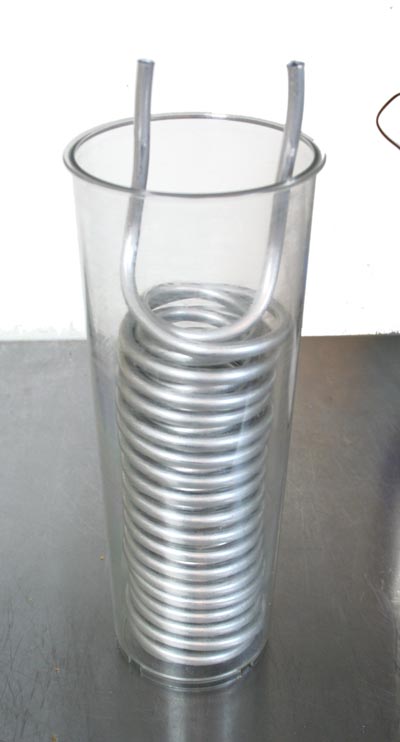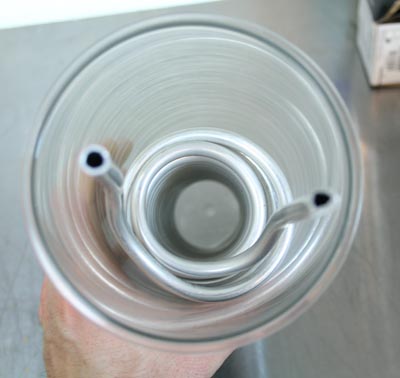posted by Dave Arnold
As readers of this blog might know, I’m building my own rotovap. I think I can improve on the laboratory rotovap (I know I can). For the reasons to make a new one, see here. If you don’t know rotovaps, see here.

Aluminum condenser for my rotovap

Condenser for my rotovap top view
Here is the condenser section of the new rotovap. I made it from 3/16 in soft aluminum tubing (purchased from McMaster Carr). I chose aluminum because it is super-easy to bend, is a great heat conductor, and doesn’t impart any taste to the distillate. I have had all of my distillate running through an aluminum pump adapter for years and haven’t had any corrosion or off tastes. This condenser has a larger surface area than the one on my Buchi, but is of similar design. Unlike regular rotovaps, however, this condenser can be taken apart to clean easily (finally!). This condenser also won’t break. The cover for the condenser is a super-custom piece of polycarbonate (a Click-Clack pasta storage container from the Container Store).
If you’re like me and don’t have a real shop or a bending jig, this type of tubing can be bent fairly well by first bending the coil into a large cylinder (a large bain marie) and then tightening the coil around progressively smaller cylinders (I ended up on a rolling pin). When the coil is large you can make pretty large reductions in diameter between steps. When the coil is smaller you have to make smaller reductions in size. I used maybe 7 different sized cylinders (wine bottles, pipes, etc). The only tough part is doubling the coil back on itself. It just takes some practice.
I’m just sorry I won’t be able to work on the project more till July 13th cause I’ll be traveling.

Coming to Mexico?… This new rotovap looks pretty pretty pretty good Dave, no more being afraid of habanero.
wonderful to see the process and desire to create a functional kitchen version of the rotovap
A
:o) Hey, are y’all going to post the sabering video from the demo this week?
I can’t wait to see the finished plans. I would love to build one of these.
There is a better, faster, foolproof way to bend the tubing. The big danger when bending tubing like this is that it kinks, which is why you have to start large and carefully get smaller. To prevent kinking, pinch off one end of the tubing with a vise or a good pair of pliers. Then straighten out the tubing and fill it with a fine sand. Any clean sand will do. Once the tubing is completely full of sand (tap the end on a concrete floor a couple times to pack it down real good), pinch off the other end. Now when you bend it, the sand is incompressible so the tubing will keep a constant volume and it won’t kink. You can start out with the rolling pin, bend the remaining ends up the center, or put any type of curvature you want into it and not worry about kinking it.
When you’ve got the shape you want, use a tube cutter to cut off the pinched ends and dump the sand out. Finish off by running water through it to remove the residual sand. I’ve made several heat exchangers in my lab this way and it works flawlessly every time.
I can’t wait to see the finished rotovap!
I actually purchased some cerro-bend alloy to do the tube bending but didn’t end up using it because I couldn’t immerse the entire tube in hot water. I’ve always wondered if the sand trick works.
The sand trick works great. I use it on thin walled copper refrigerator tubing all the time. We get a very fine sand in the lab, Washed Sea Sand from Fisher Scientific. It’s cheap, it’s reusable, and because it’s a relatively uniform size and well washed, it flows very well, so it’s not a problem to fill as small as 1/8″ tubing.
Why do you need to build a rotovap? In synthetic chemistry lab, rotovaps are great if the non-volatile evaporation residue are what you are after. But they literally suck at recovering the distillates; the losses are too high.
What you really want is vacuum distillation still. The rotovaps prevent “bumping” of the distilling liquid by spinning the flask. But there is much simplier way: stirring. Buy some second-hand magnetic stirplate on e-bay, preferably a large Corning model because it is more powerful. You can get one for less than $150. Add a large teflon-coated egg-shaped stirbar into your distillation flask placed on a heating bath, connect it to some common condenzer, with a receiving flask. For a bigger oomph cool also the receiving flask on crushed ice/salt slush bath. The advantage: no motor and spinning parts (except for the stirplate), no problems with rotating seals, very little losses of the distillate if you adjust the pressure and temperature correctly.
You don’t have to worry about continuously removing the distillate. Breaking the vacuum is non-issue when your total allowed volume in the distillation flask is 3 liters. At 15% original alcohol concentration and 90% final concentration in distillates you will produce at most only half liter of distillates – so get a bigger receiving flask instead!
Hi Milkshake,
I’ve used stir bar agitation for my vacuum distillation tests in the past but they never generated the surface area that I get out of my rotovap. I agree that the rotary seal is a huge weakness of the rotovap which is why my new one won’t have one. I am spinning an inclined cylinder inside the vacuum to agitate and provide surface area without having to use a crappy vacuum seal (using a magnet). You’d be surprised how much flavor loss you get from your distillation flask even when it’s kept on a crushed ice/salt mixture. That was the system I used to use prior to getting the peristaltic pump. Remember, I’m dealing with a distillate that has dozens, sometimes hundreds of different compounds in it in trace amounts. It isn’t that the flask isn’t big enough, it’s that it steals flavor! That is the main difference between kitchen rotovapping and lab rotovapping. I also need to be able to taste to see when the distillation is over, which is the other advantage of the pump. Theoretically I shouldn’t be getting a lot of loss off the flask because it is so much colder than the water bath, but empirically, I do.
I wish to product your imaging rotovap with you .
Your idea is as same as I.
I am making my own rotovap too, although I am still in the early stages, During my research I stumbled upon this website, and I have to say its very inspiring, who knew chefs are some of the best scientists in the world?
I am first working on the rotation mechanism which I am making out of a 5 amp black and Decker power drill, I attached a fan-speed knob onto it (the same kind of knob you see on light dimmers switches) it allows me to adjust the speed of the power drill.
Anyway, there is a problem with it right now and that is that it goes way too fast at its high settings, so I am going to put a resistor to slow it down some, but I don’t know exactly how much resistance I should put on it because I don’t know how fast rotovaps are supposed to spin.
Once I have that I was thinking of going to a machine shop to fabricate the head and maybe help me bore a 1 inch hole through some of the gears. Then there’s a matter of mounting the gear to a holding plate of some sort.
I haven’t thought as far as the condensor, yours seems like a good idea, but I was a bit concerned with the reactivity of aluminum to some of the chemicals for my purposes you might be running through there, here is a link to some chemical resistance charts
http://www.pneuaire.com/chrech.html
its broken up into three charts in alphabetical order, and uses an A-F grading scale A (least reactive, F very reactive) I’m sure for food products alumium would be fine
The problem I have is knowing what to use as a pump for the condenser, I was thinking of getting it from a mini fridge or something – but I don’t know if that will be too powerful or not powerful enough.
then there is the matter of filling up the condenser with the freon or whatever the cooling solution is going to be. I know little about refridgeration except the basic concepts.
I don’t understand why rotovaps are so expensive, $7,500 for something that basically consists of 2 round bottom flasks, a condensor, a low speed rotor and a vacuum. It shouldn’t cost much more than $250.
Yeah, the cost is crazy. Your chiller should do around -20 C (-4F) You need at least 600 watts of cooling at those temps. Rotation doesn’t need to be that fast –50-100 rpm.
Dave
I think you are absolutely correct the vacum seal seems to be the big headache in the normal rotary vap design, and I think I can see how our ingenious design gets around this
I’m trying to see how your design will work from the information you have already given. Can I just clarify a couple of things.
1. The polycarbonate cylinder does this just act a a stirring paddle forcing the fluid against the shape of the base.
2. Are you taking off the vapour from a connection on the lid or the base?
Hi Stephen A
I am taking the vapor off through the lid.
The polycarbonate cylinder spins inside the chamber and created the stirring and the large surface area you get inside a regular rotovap. In fact, it provides more surface area, because a film will be formed on the inside and the outside of the cylinder.
Hi Dave
Thanks for getting back to me. Ok the last bit that is doing my head in is the drive. From what I understand the drive will be isolated magnetically from either side of the end of the base so you don’t have any problems with holes that need sealing .
Is this an off the shelf coupler or have you designed one that is powerful enough to act through the end of the base?
Off the shelf but pricey!